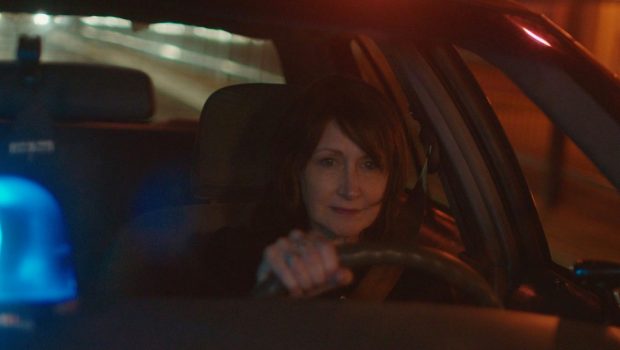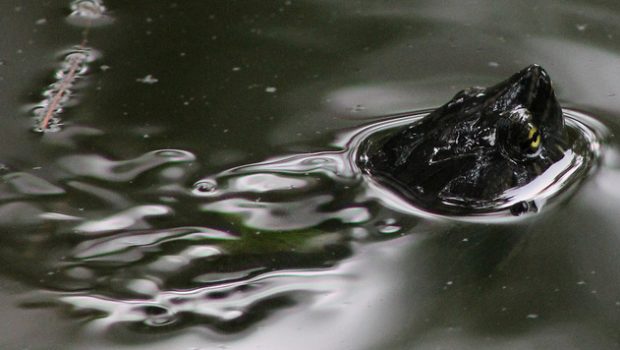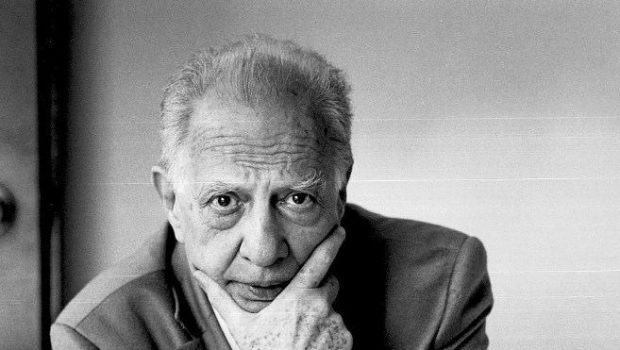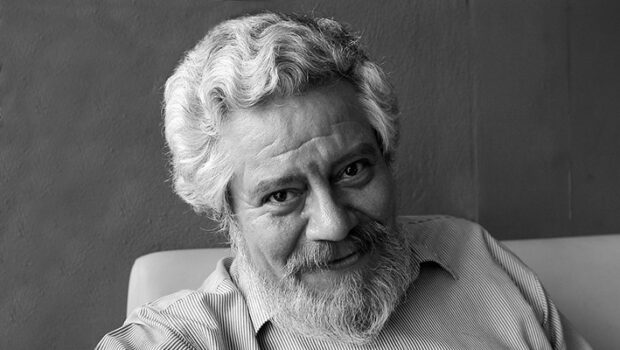Take Back the Night
So Mayer
At the end of September, amid the rage and heartache following Dr. Christine Blasey Ford’s testimony, US-based civil rights activist and podcaster Danielle Muscato asked on Twitter: “Ladies… What would you do if all men had a 9 pm curfew?” Over eight and a half thousand people responded, with an overwhelming focus on freedom of movement–especially in the dark, without having to carry a weapon.
So when Detective Mike Hoolihan, played to the hilt by Patricia Clarkson, walks alone, at night, into a creepy abandoned house, Carol Morley’s film Out of Blue climactically feels like the embodiment of Muscato’s question. Out of Blue, Morley’s fifth feature, could not more literally–or metaphorically–be a film about taking back the night. Hoolihan is investigating the death of Dr. Jennifer Rockwell, an astrophysicist found shot the morning after delivering a public lecture about the stars. Animations of star formation and death, of the Milky Way overhead as it is no longer visible in our overlit cities, strafe the film, a reminder on the cosmic scale of what women, trans and gender non-conforming people lose through not being able to walk without fear in the dark.
In one scene, Hoolihan lies alone on the bonnet of her car, stargazing as she thinks her way through the crime. She also takes to the catwalk at a strip club, dancing with the dancers in pairs and in a group, and walks into dangerous situations alone – and well-prepared. “There are many ways of being a woman,” she tells Jennifer’s mother Miriam when she spites her for her masculine appearance (a Grand Guignol performance of grief and guilt from Jackie Weaver). One of them is confidently knocking out a man twice your size when he jumps you after calling you “cosmic corruption.”
Boom. But Hoolihan is no clichéd Strong Female Protagonist. For a start, she’s not alone: she has a boss, Janey Mac, a potential new friend, Stella Honey, and a cat. She talks to all of them, and they all look out for her. She also only uses physical violence as a last resort, and in self-defence–and it’s far from the climactic moment (although there was definitely a sursurrance of “Yessss!” around the cinema when Hoolihan dropped Jennifer’s boorish brother). And she is no superhero: her sobriety cracks under the pressure of the case; she pulls an unlicensed weapon on a suspect; and she is – the film suggests – afraid of the dark.
The night after she’s called to the murder scene, Hoolihan lies in bed looking at the dark, her cat by her side. She picks up her hand torch and flicks it on/off on/off on/off, rapidly. In the film, it leads her to a key clue, to visualise the absence of something at the murder scene. The torch remains ever-present when she is in bed, however, and not just because of the regular brown-outs that plague the police station and her apartment building. On/off on/off on/off: it’s both a stimulus to thought, and a way of handling fear – the fear that arrives as Hoolihan increasingly visualises not only the absences and presences of the murder scene, but the way they evoke other scenes, scenes of other murders that she has read about, and scenes from her childhood that she has forgotten. The flash of the torch illuminates in snippets as she confronts her past, going into the dark.
Out of Blue offers a dazzling entry in the current canon of female detectives searching for gender justice, and it will be fascinating to hear Morley talk about the work of Jane Campion, who created two of the great entries: Franny in In the Cut, a Queen of the Night of unconventional confidence, a strip club habituée with a sharp tongue that is echoed in Hoolihan’s; and Robin Griffin in Top of the Lake, who–like Hoolihan–finds her professional investigative work taking her deep into her own memories. Given the rarefied entries, it’s too soon to call this a trope, although Katherine Connell suggests ‘female Oedipus’ over at Another Gaze, and lays out how the self-detecting woman has a different relationship than the other Oedipus to both knowledge and power. The self-detecting female detective (who often does have “many ways of being a woman”) offers clues to the feminist critic as well, for new ways to read new stories. Hoolihan’s rapid gaze and power of recall, her eye for a gesture, a texture, a decoration, an ornament, draws the viewer into a new way of watching.
And it works. I thought of her flashing torch, and of the fear and courage it denotes, when watching a short at the London Film Festival, the day after Out of Blue had its European premiere as a Gala. Tom de Ville’s Corvidae may share Maisie Williams with Morley’s previous feature The Falling, but it has uncannily more in common with Out of Blue. Maybe it’s the zeitgeist finally bringing us complex female protagonists who go out to confront their fear: the unnamed protagonist of de Ville’s film also arrives at the scene of an attack and goes after the perpetrators. In this case, the victim is a crow, injured by a boy with a slingshot, and the girl spends a night nursing it. She sits in bed, flicking her torch on/off on/off on/off, trying to keep herself awake, and keep an eye on the stunned bird. A girl, a bed, a companion animal, a light: in both films, it’s the other side of violence, a response that is also an investigation, a self-fortification that reveals vulnerability.
Both the girl and Hoolihan find themselves taking on the bully-boy patriarchy, which comes for them wearing masks, that familiar signifier of the slasher (such as the indefatigable Michael Myers). But the films are not just about stripping off that mask, and also the fear it generates while hiding the true threat, but also how the masking of gendered violence pushes women, trans and gender non-conforming people to mask themselves–to hide or mistrust their memories, knowledge and identity in order to survive.
In investigating Jennifer’s death, Hoolihan works through (and dismisses) that classic move beloved of male auteurs: the meshed female double, as seen in Persona (Ingmar Bergman), et al. The film draws Jennifer and Hoolihan closer and closer together, using both parallel universe theory–disquisited by Jennifer’s boyfriend Duncan Reynolds, a physics professor–and some clever cinematography and editing to suggest such a blurring. The ending resolves that duality as, instead, the way that patriarchy works by repeating itself, ad infinitum. It’s not the women who are the same (or who fantasise about disappearing into each other), but the acts of men that not only produce but fetishise the traumatic similarities between them–and thus the female investigator has become a beloved trope, because it offers the possibility of disruption.
As at the end of The Falling, the protagonist’s brush with suicide leads to revelations that reconnect her to her mother. But, in The Falling, the connection goes through the mother to a networked world of female friendship and genealogy, and toward the possibility of solidarity. Out of Blue’s Hoolihan turns out to be more solitary than she seemed, even while –as the detective– she carries the network of all the women murdered by the same serial killer she is pursuing. Finally, for whom is the film taking back the night through Hoolihan? Given the levels of corruption and racism in the New Orleans Police Department that were revealed by post-Katrina investigations, Out of Blue’s title may also refer to bringing ‘the boys (and girls) in blue’ out of disrepute. Hoolihan and her colleagues are hard-working officers, and it is unclear how critical the film is (or asks us to be) in a scene in which Hoolihan has a black male suspect held in an interview room, refusing him a lawyer and slamming the table and door violently to scare him into co-operating or confessing. As Kathleen Kampeas-Rittenhouse warned back in 2015, “as empowering as it can be to fantasize about ass-kicking (or ass-enlightening) feminist officers, it’s worth questioning the extent to which an institution whose mandate is fundamentally conservative can truly be radicalized, let alone radicalized by white women.”
That institution might be cinema as well as the police force and judiciary. Pamela Hutchinson (in an article quoting Morley) summarises a year of supposed activism against gendered violence in the film and television industries by noting that, “much of the first year of #MeToo has been dominated by the comparatively privileged voices of white female Hollywood actors, by guidelines and plans announced but not necessarily put to the test, and a focus on individual rather than collective action.” Out of Blue (without giving the plot away) does go some way into revealing how the white patriarchy uses material wealth as well as emotional blackmail to recruit white women to do its bidding–and what happens when the wives and daughters that men with power are so fond of invoking rebel.
But it could go further toward imagining resistance, especially as the film surrounds Hoolihan with supportive, intelligent and interesting black women, including the elderly, blind Miss Tolkington who gives her the crucial clue. The possibility is latent, palpable; not least because it’s set in contemporary New Orleans, although the only real sign of that is the red spray paint marking the side of Miss Tolkington’s shotgun house, showing how high the water rose in 2005. It is hard to place the film, other than this small detail, in the time and place it claims, even as (or because) the film works explicitly to exorcise both gothic and noir as genres that entrap and punish white women.
Hoolihan’s final revelations when she braves–and frees herself from–the creepy abandoned house are moving and undoubtedly powerful, but I am not sure they are enough. In some ways, Out of Blue has the feeling of itself having come from a parallel universe, in which Hillary Clinton is president and questions of gendered violence, while urgent, are not the burning issue of the day spanning from Brazil to India, and connecting necessarily to every aspect of human and other-than-human rights, from Black Lives Matter to stopping climate change. And maybe the idea of parallel universes that Duncan demonstrates to Hoolihan with parallel mirrors is, in fact, smoke and mirrors, an easy way out; what’s really going on here is quantum entanglement. The blue marble that Hoolihan wears around her neck, the token of her origins drawn straight from classical tragedy, finds its pair in among Jennifer’s possessions. And thus a bigger ethical question emerges about our responsibility to each other, given our entanglement at both atomic and affective levels.
Explicitly, albeit briefly, Corvidae asks what it means to commit truly to being–because we are entangled–(in the words of British modernist novelist Sylvia Townsend Warner, a lesbian Communist pacifist) “with the hunted.” In protecting the crow, the girl ties herself to crowkind as an act of solidarity, and it changes her. It offers a vision, as a short fantastic film can, that both resonates with Out of Blue and steps further: into blue, into what comes next when we have taken back the night together.
*Cover image ©Independent Film Company
 So Mayer is the author of Political Animals: The New Feminist Cinema, The Cinema of Sally Potter: A Politics of Love, and the co-editor of Catechism: Poems For Pussy Riot, The Personal Is Political: Feminism and Documentary and There She Goes: Feminist Filmmaking and Beyond. Her Twitter is @tr0ublemayer
So Mayer is the author of Political Animals: The New Feminist Cinema, The Cinema of Sally Potter: A Politics of Love, and the co-editor of Catechism: Poems For Pussy Riot, The Personal Is Political: Feminism and Documentary and There She Goes: Feminist Filmmaking and Beyond. Her Twitter is @tr0ublemayer
©Literal Publishing
Posted: November 5, 2018 at 9:37 pm










